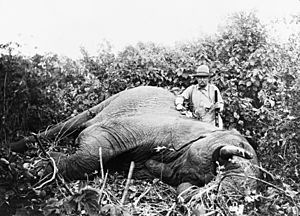Elephant gun facts for kids
An elephant gun is a very powerful type of gun, often a rifle. These guns were first made for hunters who wanted to hunt very large animals like elephants.
Contents
Early Use of Elephant Guns

When people from Europe started exploring Africa in the early 1800s, they needed strong guns. These guns were for protecting themselves from dangerous animals, hunting animals for food, and later, for sport.
At first, hunters used simple shotguns loaded with solid lead balls. But these guns didn't always kill large animals easily. Some people said it could take many shots to bring down an elephant! So, people started making bigger guns called elephant guns.
These early elephant guns were large smoothbores that used black powder. The size of the gun's barrel was measured in "bore" or "gauge". Sometimes, the guns were named by how much the projectile (the bullet) weighed. The bullets were usually round lead balls or cone-shaped slugs. Sometimes, a metal called antimony was added to make them harder.
These heavy firearms were the first true elephant guns of the black powder era (around 1850–1890). They weren't just for elephants. Hunters also used them for other big, dangerous animals like the rhinoceros, the hippopotamus, and the cape buffalo. Black powder bullets couldn't go faster than about 1,500 feet per second (460 m/s). So, to make them hit harder and go deeper into an animal's skin, the guns had to be made even bigger. Even then, these slow, heavy bullets sometimes struggled to go through thick skin or bone, especially when trying to hit an elephant's brain.
Modern Elephant Rifles
Around 1895, a new type of elephant gun appeared: the Nitro Express rifle. These guns used smokeless powder, which was a new invention. With smokeless powder, bullets could be smaller, made of metal, and travel much faster (around 2,000 ft/s (610 m/s)). This meant they shot straighter and could go much deeper into targets than the old black powder guns.
Because of these improvements, the older, very large black powder guns slowly disappeared from hunting fields. In the early 1900s, new rifles were made as single-shot, bolt-action, or double rifles. They were used until ivory hunting became less common in the mid-1900s. After that, elephant guns were mostly used by game wardens and as backup guns for professional hunters.
Later, in the 1970s and 1980s, safari hunting became popular again. This led to new elephant guns being made, like the .416 Weatherby Magnum and the .416 Remington Magnum. Even more powerful elephant guns were developed, such as the .700 Nitro Express and others like the .585 Nyati and .585 Gehringer. These new guns showed how much power a hunting rifle could have.
What Makes an Elephant Gun Special?
All elephant guns share one main goal: to have enough "stopping power". This means they can quickly stop a charging animal and keep the hunter safe.
But it's not just about being powerful. An elephant gun also needs to be:
- Easy to carry for a long time.
- Possible to shoot from different positions.
- Well-balanced, so a hunter can aim at fast-moving animals.
In short, an elephant gun is a very large and powerful hunting rifle, designed for the toughest hunting situations.
Elephant Guns in War
Elephant guns were not only used for hunting. They also played a small part in wars.
During World War I, both the British and German armies used elephant guns. They took these guns from their African colonies. The British used them against German snipers who were hiding behind thick steel plates. Regular infantry rifles couldn't shoot through these plates, but elephant guns could! The Germans also used a special anti-tank rifle, the Mauser 1918 T-Gewehr, which was similar to an elephant gun, to fight lightly armored British tanks.
In 1941, during the North African Campaign, Italian soldiers in East Africa fought the British. They didn't have enough anti-tank guns. So, the Italian commander, the Duke of Aosta, gave his personal collection of elephant guns to his soldiers to shoot at British armored cars.
The Finnish 20 mm anti-tank gun Lahti L-39 was nicknamed Norsupyssy (which means "Elephant Gun") during the Winter War. This was because it had great stopping power. However, it wasn't a true elephant gun because it was made for military use, not for hunting elephants.
Related pages


